As a slight departure from my usual indie fighting game coverage, this time I’m writing a detailed review of a recently released game: Fight of Steel: Infinity Warrior. I have already talked about my early impressions here back in May, during the first open beta, but this time we are back for the full course. Is Fight of Steel the robot-centric fighting game we were waiting for?
It’s review time!
Around two months ago, I have had the pleasure to play a beta version of Fight of Steel: Infinity Warrior and entrusted my early impressions to this article on this very website. Now, since the game has been released on 14.07.2022 on Steam, it’s time to delve into its complete version and see how it evolved from its last open beta.
Since this is a graded review, I will split its content into several thematic paragraphs: Gameplay, Graphics, Sound, User interface, Online modes, Single player content, and Story. The Miscellanea paragraph at the end contains thoughts and evaluations that I wasn’t able to fit into any other section.
Disclosure : I have received a free review key from the developer Digital Crafter the day before the game was published.
Explanation of the grading system
Each section is graded 0-10, with 0 being a broken mess that doesn’t even start, 1 being an absolute disaster, 3 being totally insufficient, 5 being mediocre, 7 being good, and 10 being perfect (interpolate all other marks as required). Marks under 5 are given only for broken experiences riddled with bugs. Only integer marks are given. The final score is not a mathematical average of all the section scores but rather a measure of how much I think the game is worth on its own merits as a complete package.
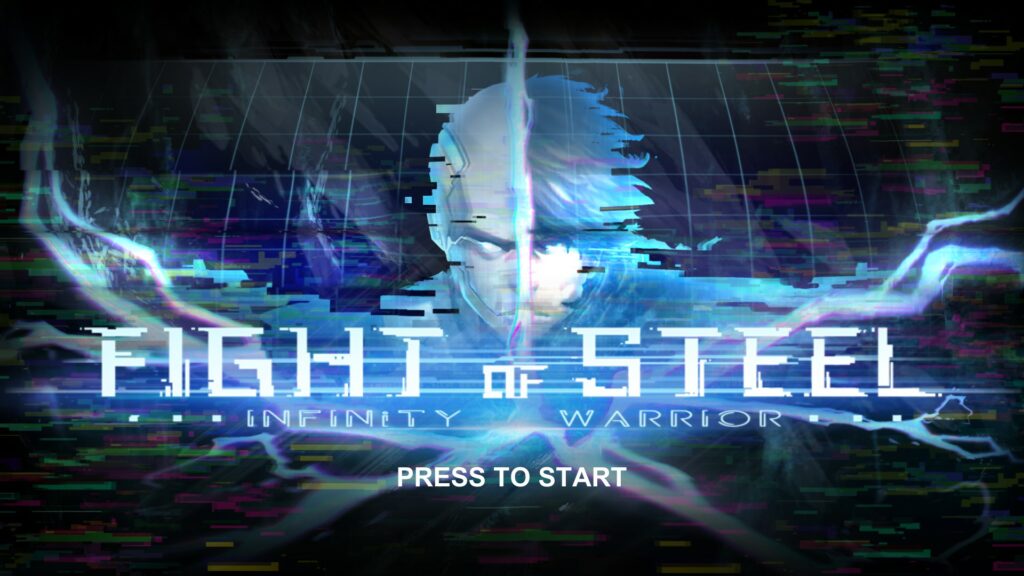
Gameplay
Fight of Steel is the third traditional fighting game made by Digital Crafter, after Fight of Gods and Fight of Animals and shows it very clearly in terms of game feel. The game is a six-button fighter, with four attack buttons (Light, Heavy, Special, Grab), a Super button and an Overdrive button. Special moves are performed by inputting a direction together with the Special button. Pressing the Heavy button together with Special will result instead in a more powerful Ex Special Move, for the cost of one stock of super bar.
Overdrive can be used both as an offensive and as a defensive burst, and triggers a specific Overdrive install, which allows for unlimited uses of Ex Special Moves as long as this status lasts. In my tests, I could use up to four Ex Special Moves before i emptied the overdrive bar.
The most important take-away is that Fight of Steel takes very heavy hints from its predecessor Fight of Animals, as its combos are all built around the idea of dash-canceling successful hits. Much like Fight of Animals, one lives or dies by dash cancels and one Light attack can easily confirm into a 30-40% meterless combo. Contrary to its forbearer, however, Fight of Steel has a basic damage scaling in addition to gravity scaling, somehow reducing the impact of a misplaced block. Even though I haven’t found any so far, there might still be some touch of death combos, but not as easy achievable as in Fight of Animals and requiring far more resources.
The moveset customization is one of the staples of this game, as it allows for tons of experimentation and player expression: Each player can build their own character by using one of four different set of normal moves, plus three special moves that can be picked from a pool of around 60 different ones, and one super move. There are specials for all tastes, including parries, rekkas, full screen projectiles, command grabs, flash kicks, shoryuken and even a Sektor-like teleport punch attack. Super moves are a bit more restricted in scope, but overall have their own flavors and it’s relatively easy to find something of one’s liking. Such a variety can create some issues in terms of competitive viability, though. I will write more about it in the Miscellanea section.
The controls are very responsive and the game feels very good in hand. Once one gets the hang of dash cancels, putting together custom juggle combos feels extremely satisfying. However, sometimes—especially in the corner—I had the feeling collisions might be a little finicky, causing unwanted cross-ups and combo drops.
Overall, the gameplay gets very good marks. Fight of Steel might be one of my favorite new games in terms of game feel and I strongly advise anyone who liked the previous “Fight of” games to check it out, as many legacy skills transfer very well to this title.
Score: 8/10
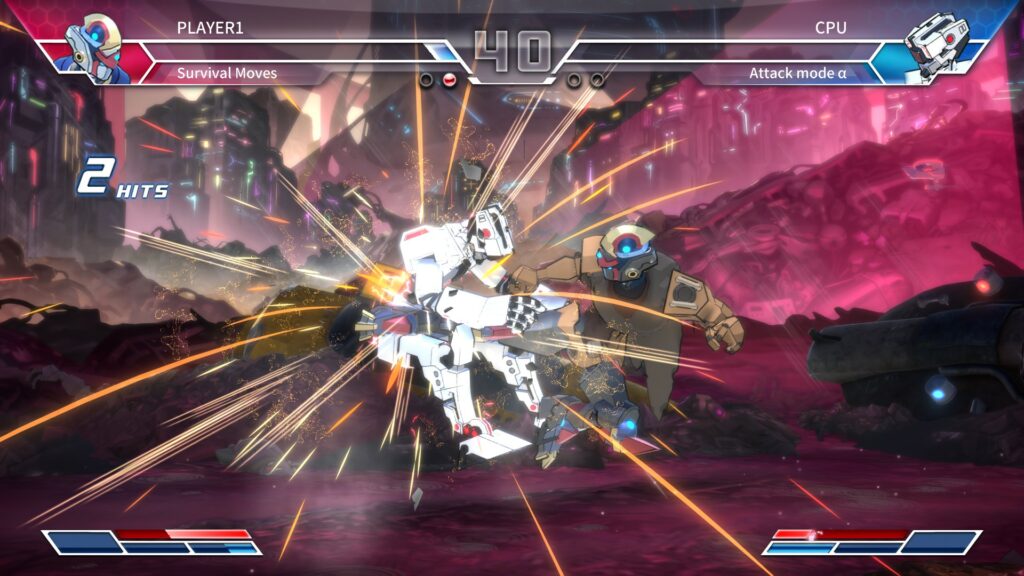
The gameplay is snappy and incredibly satisfying. Chaining combos and dash cancels together feels just right. Also, the stages are gorgeous.
Graphics
Fight of Steel: Infinity Warrior shows a clear evolution in the graphics department, compared to previous Digital Crafter games. The 2D backgrounds and character artworks are nothing but gorgeous, the stages are amazing, and the story mode cutscenes are delightfully crafted. The 3D models used for the robots are extremely well done and almost every customizable part feels unique, despite the impressive amount of items available. Everything shares a nice feeling of self-consistency,
The only sour note are the humanoid models, which fall very deep inside the uncanny valley. The human heads do not have any change of expression and the humanoid arms are equipped with comically oversized hands and very broad shoulders, which make builds like Artemis (the female protagonist whose parts can be unlocked in Story Mode) quite strange to the eyes.
Animations are for the most part good, but there are some dips in quality in the form of rough transitions (e.g. the “Core Burning” super, which goes from the character crumpling to the ground to standing back in their idle position almost instantly). Command grabs in particular look rather clunky at times and some animations feel quite jarring.
Fight of Steel isn’t an AAA title and it would be unwise to expect the same graphical fidelity as one. For an indie game, its presentation is way above average and deserves praise.
Score: 7/10
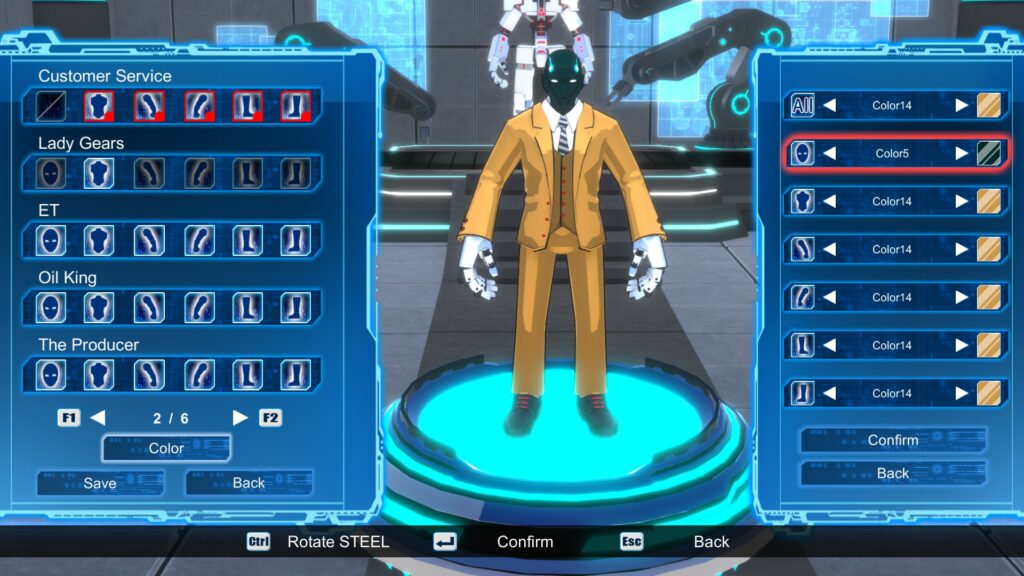
There are a lot of parts to choose from, so I went and made Mystery Johnson. Shame that the true black color costs 50.000 credits…
Sound
The soundtrack of Fight of Steel: Infinity Warrior took me by surprise. Each stage song is memorable in its own different way and I found myself whistling a couple of them while going out on a stroll. The hit effects are crunchy and do their job very well. There is no voice acting, but this doesn’t feel like a huge issue, due to most characters being robots. The techno/beat-heavy music fits the world and characters perfectly and it’s one of my highlights for the game. Fight of Steel ranks quite high among my favorite indie fighting game soundtracks, at the same level as The Black Heart and Beatdown Dungeon.
Score: 9/10
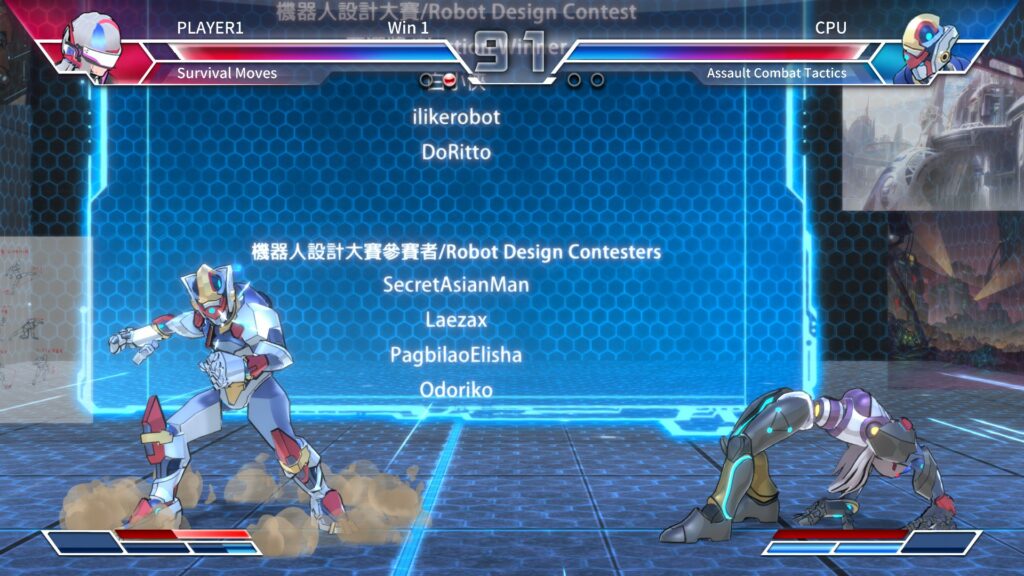
The game credits scene doubles as a stage. It’s a pretty nice solution and a very creative one at it. Furthermore, one can also play it in VS mode as a normal stage—no need to clear Arcade or Story mode to see it.
User interface
This is where Fight of Steel: Infinity Warrior loses some points. While the UI is a massive improvement compared to the previous iteration in the beta, it’s still not as polished as it could be. Going to the in-game shop and being explained every time how it works by the store owner robot is tedious, I lost count of how many times I exited a menu by mistake and moving through the various options in Challenge mode is a bit of a chore. The menus are graphically impressive, but their usability is lower than I would like to. Not a full miss, but it’s probably the least polished part of the game.
The text tutorials are also a bit too “front-loaded” in terms of information. They are good as information cards, but not excellent as learning material, as they seem to get in the way the first time a new menu is opened.
Score: 5/10
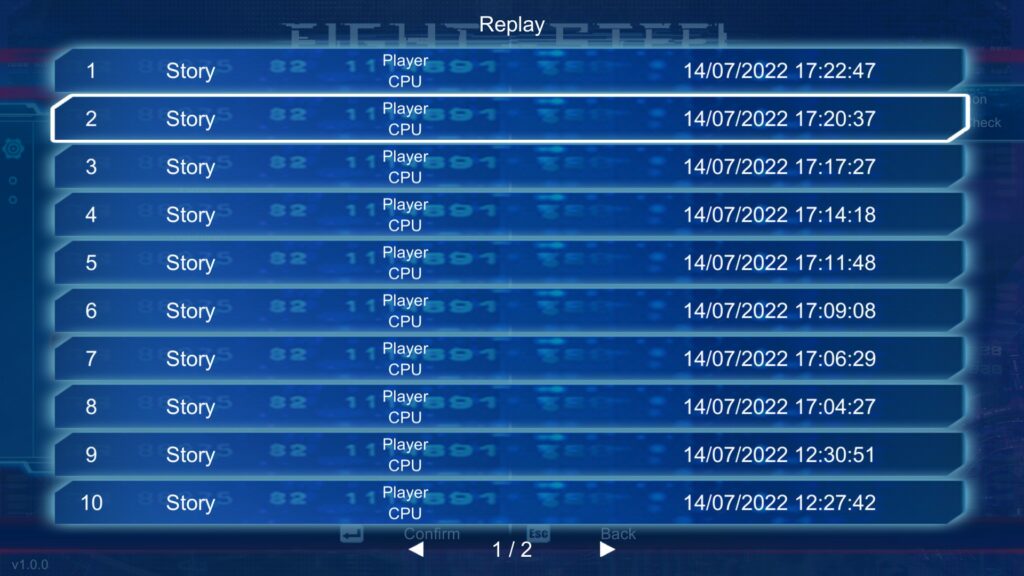
The last 20 replays are saved automatically in a separate section in Collection, whether you are playing against the computer or another human being.
Online modes
Fight of Steel: Infinity Warrior uses Digital Crafter’s own rollback netcode solution, which makes use of relay servers to create a bridge between two players. I have tested the netcode on Wi-Fi (yes, I wanted to perform a stress test) and went as low as a 2-bar connection in ranked mode. That particular match had several rollbacks, but it felt very playable despite that. Every time I dropped a combo, it was because of a failure of my own execution and not because of the quality of the connection.
Ranked mode worked very well. I can’t share my thoughts about the progression system because I didn’t grind it enough, but online might be quite hard for a newcomer due to all the people who transferred their legacy skills from Fight of Animals and from the previous betas.
As an additional bonus, there is a built-in replay mode that keeps track automatically of your last played matches, whether against the AI or a human opponent. It’s a handy feature and it works out of the box to analyze one’s online endeavors.
My only gripe is that Casual Match requires players to create rooms on a relay server, instead of sending them into a pool of people for quick matchmaking rounds. A separation between Player Match with rooms and lobbies and a Quick Match queue, as Street Fighter V and Tekken do, would have been much more user friendly.
Moreover, players residing in African countries might want to wait a bit before buying this game as, at the time of writing this review, there are no African relay servers. This means that players from those regions need to connect to e.g. EU servers even for matches inside their own country, artificially increasing the latency and making the connection quality worse. I will update this review if the developers issue any additional statements on the topic.
Score: 8/10
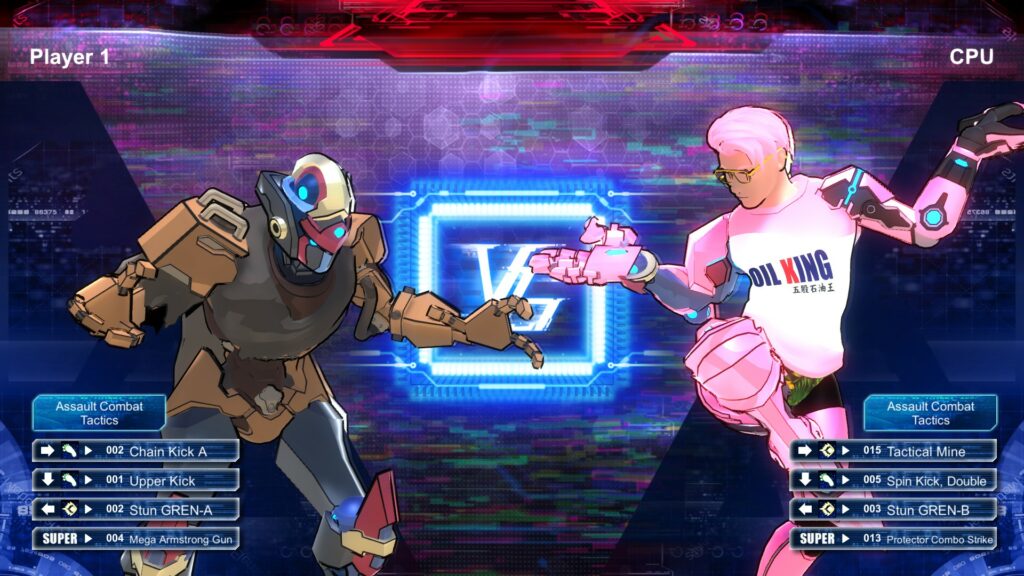
Arcade Mode pits you against randomized opponents, which can lead to you meeting some… interesting combinations of parts.
Single player content
Contrary to the current trend of the genre, Fight of Steel: Infinity Warrior does a lot to make its single player content appealing. There is a classic Arcade Mode, a Story Mode comprising (at least) eight fights with a cool boss battle at the end, and a very interesting Challenge Mode. Challenge Mode is unlocked by clearing Story Mode once, ties with the game’s story and consists in a set of maps with several encounters.
In Challenge Mode, you can build your robot only by using random drops with RPG-like stat boosts, obtained after every match. Moreover, each opponent is equipped with a specific element and is weak to a its opposite element, forcing you to constantly rebuild your robot with parts dropped by them and optimize your setup to hit where it hurts. Challenge Mode is also the only way to unlock the so-called World Files, which offer a more complete view on the worldbuilding of the FoS universe.
[Reviewer’s note: As of the time of my test, the Hard variant of challenge mode was not yet available]
Overall, I liked the concept a lot, but later levels can feel like a grind. The amount of credits earned through this mode is also not stellar, compared to playing Arcade or Story.
Speaking of credits, there is a lot to unlock, be it new moves, new parts for your robot or colors. To help with the grind, there are daily login bonuses , daily missions and weekly missions that can be used to obtain a satisfying amount of credits.
The AI is sufficiently challenging and can shred a player that doesn’t know a modicum of combos, especially at higher difficulty levels. However, I have found some exploits, like going for a low sweep into special cancel very often. The AI, even at higher difficulties, seems to have issues with performing and blocking against low attacks, which I shamelessly exploited to reach the True Ending in Story Mode. The story boss is less susceptible to this tactic, though, and gave me a rude awakening when playing at Very Hard, countering my puny low kicks with a low-invincible jumping stomp.
I had a blast with this game’s single player content, which makes it shine as a good outlier in a genre focused on its competitive aspect. All things considered, it’s crazy how Digital Crafter packed all this stuff in a game with a price of less than 13USD.
Score: 8/10
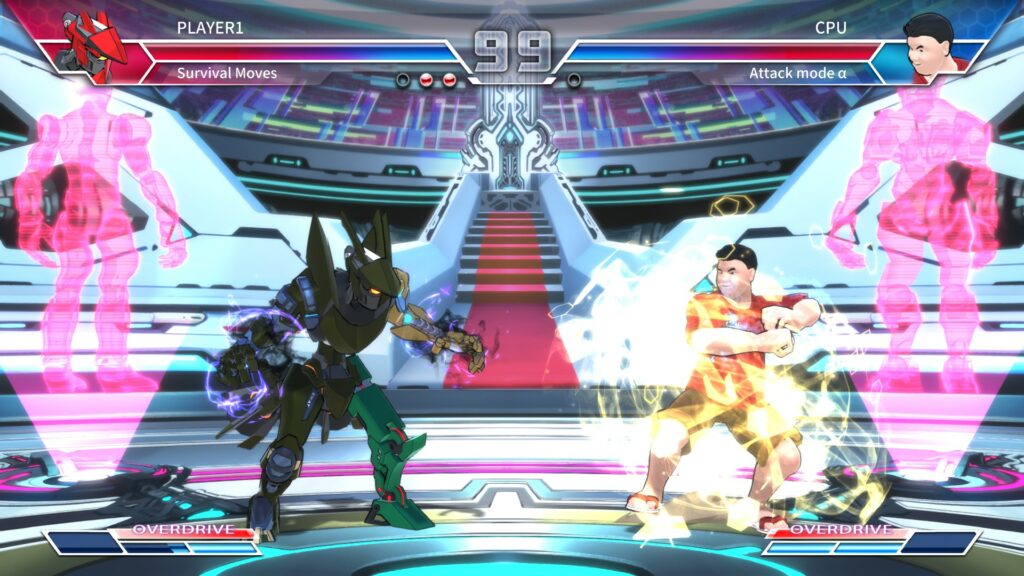
In Challenge Mode, one can unlock the appearance of Digital Crafter’s very own founder Ken Wei, in the aptly called “Producer Challenge” map.
Story
I mentioned story mode in the previous section, but I thought it would be correct to delve a bit more into its meat and potatoes. You play as Zero, an amnesiac robot who believes to be human, and team-up with a female android named Artemis in order to find the mysterious “Legacy of Humans”, in a world ruled by robots after mankind went extinct centuries before.
The story develops in the span of eight matches against a variety of opponents and is interspersed with deliciously crafted cut-scenes. The last fight ends with a rather tough boss battle, which is especially harder at higher difficulties, since the boss has almost twice as much health as the player.
There are three endings that can be reached, depending on the difficulty chosen and the performance of the player. The Normal Ending is achieved by clearing Story Mode at any difficulty with one or more continues, the Good Ending is achieved by finishing Story Mode at any difficulty without continues… while I’ll leave the conditions for reaching the True Ending a bit of a mystery. Just know it might be harder than hard to get it.
What I can say in this review, is that it doesn’t require Challenge Mode and is independent on the number of perfect wins or super finishes. I’ll let you churn your fingers on your controller to get it, but know that it’s absolutely worth it.
The Normal and Good route weren’t very interesting to me, as they are filled with some overused clichés. The True Ending route, however, gifted me with one of the best WOW moments I had while playing an indie fighting game. Right after I defeated what I thought to be the last enemy, the game took me for a ride. That conclusion alone is worth the grind, and I strongly suggest you to try to reach it, and to have a loooooooot of patience (I’ve left some clues in this text on the requirements, piece them together as the detective you’d like to be).
Clearing the True Ending is also necessary for a Steam achievement and for unlocking the Artemis V-Tuber set, so depending on your completionism urges, you might want to have a shot at clearing its requirements.
Now, on a more precise analysis, the game’s story is saved by its True Ending. The pacing is good, if a bit too fast, but some memorable characters, like Captain Alpha, get very little screen-time compared to their importance in the game’s world. I know that budget-wise it’s prohibitively expensive to have a longer story, but this is one of the cases where a longer, slightly slower paced plot might have worked better.
Zero, Artemis and [REDACTED] are the only characters with a significant backstory, with all other characters being rather plain or undeveloped. While the files unlocked in Challenge Mode help piecing together a bigger picture (and contain a lot of Digital Crafter-related Easter eggs), this is not enough for putting together a more cohesive narrative.
By considering only the Normal and Good ending, Fight of Steel’s story is a 5/10, but still better than the excuse plot of even some AAA fighting games. At least, it has a coherent goal for its characters and feels like a lot of care was taken in putting things together. The True Ending route, though, elevates it to 7/10 due to the additional revelations and the charisma of a certain character I can’t and don’t want to spoil. Just know that I have no regrets after playing it and that I would go through the hell required for unlocking it again.
Score: 7/10
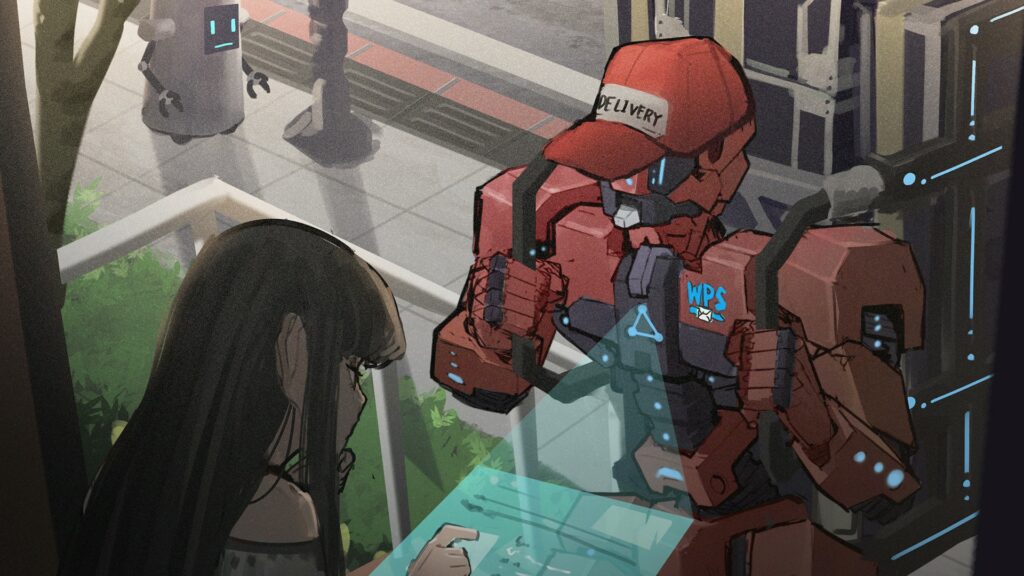
The cutscene pictures in Story Mode are a feast for the eyes and are drawn with love and care. Furthermore, this delivery service skin can be unlocked in game. Since I don’t want to spoil more, I have decided to upload one relatively innocuous picture. I’ll leave the rest for you to discover.
Miscellanea
Fight of Steel is one of my indie highlights of the year so far, especially due to its attention to single player content. However, there’s a catch: Since there is no easy way to unlock all moves from the beginning, it might be hard for tournament organizers to run a tourney at a local without first grinding through arcade and story mode first.
I have calculated that one needs around 40.000/45.000 credits to obtain all moves, which means clearing Story Mode at Normal difficulty around 15 times (less if we consider login bonuses and missions). While it isn’t too much of an annoyance, it still requires a good ~5-8 hours of play.
The customization part of the move-sets is also something that might make it harder to find a competitive balance: Not all moves are created equal and some are definitely better than others. I cannot forecast how this might be handled by tournament organizers and what will the meta builds be, but it may lead to some difficulties.
In terms of controller setting options, I wish this game had an assignable macro for EX moves, since sometimes on pad I end up triggering at the wrong time. However, it’s a minor gripe, as it’s the only action in the game that requires two buttons to be pressed simultaneously.
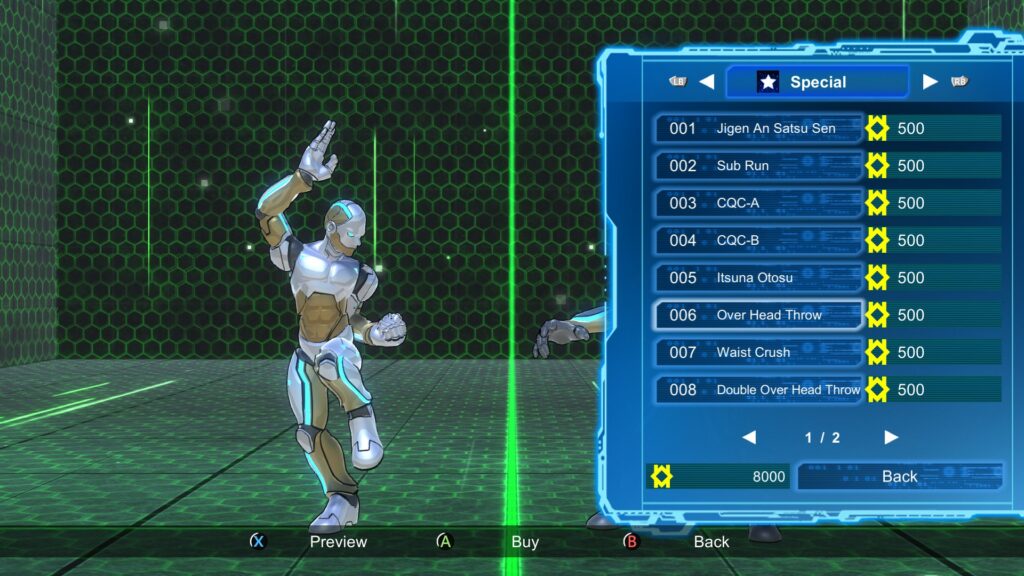
With so many moves to unlock, it might be a hurdle for tournament organizers to run a local for this game. Such a good variety comes at a cost.
Closing thoughts
Fight of Steel: Infinity Warrior is a great indie fighting game which does almost everything right. With huge amounts of replayability, customization options, and snappy gameplay, it’s a must buy in the current scene, especially for its budget price—less than 13USD. Its flaws can be overlooked quite easily, the online modes work reasonably well, and the UI, while obnoxious, isn’t a huge barrier to enjoying the game.
This game feels like a huge step forward for the Digital Crafter formula and shines as an example of what a good indie fighting game should aspire to be. The gameplay in particular shines as very polished and responsive, especially once one masters the universal dash cancel mechanic.
To answer the question in my opening paragraph: Yes, Fight of Steel might as well be the best robot-centric fighting game I have played in recent years. The small issues outlined in this review can’t tarnish the undeniable merits of this game.

Final score: 8/10
Game summary
Name: Fight of Steel: Infinity Warrior
Developer: Digital Crafter (Twitter, Steam, Discord)
Publisher: Digital Crafter (Twitter, Steam, Discord)
Available on: PC (Steam)
Price: 11.99€ / 12.99USD
Year of release: 2022
Engine: Unity
Status: Complete
Netcode: Rollback netcode
Press kit
About Fight of Steel
In the distant future, you are a martial artist who tried to recover your memories. You remember you were a Grand Master of martial arts. Now you fight various robots in the arena-like place, the Tower. Fight of Steel is a fighting game that provides ultimate freedom. In the game, players can customize their fighters from appearance to moves. And various game modes let players turn their victories into new parts and fighting moves.Customizable Fighters
In addition to the initial default characters, you will get credits after you complete some fights in different game modes, which can be exchanged for appearance parts and move chips. The move chips allow you to mix and match the moves in the game, allowing you to choose your favorite moves and perform a variety of combinations to create your fight style!Simple Controls
This game uses five buttons for moves and adopts a modern input system. Press the directional keys and skill buttons to perform a special move! Players who have never played any fighting games before can quickly get started! But while simplifying the
commands, you can also use the EX moves and the OVERDRIVE system, allowing veterans of fighting games to get a more advanced gaming experience.Smooth Online Experience
The game uses Rollback Netcode to provide a smooth online match experience. Players can fight online with fighters from all over the world.About the Developers
Digital Crafter is a small indie game studio initially organized by Ken, the producer, as an online hobbyist developer club. The members collaborated on various projects and eventually became a real game studio in 2015. Digital Crafter developed Fight of Animals and Fight of the Gods, released on multiple platforms and physical distributions. The studio has also been dedicating its effort to helping other developers who have just started developing their first games; by providing assistance and experience sharing.
Special thanks to the developer Digital Crafter for giving me a free review key for the game and for sending me a press kit. Special thanks to 老翰 LaohanJ for answering my questions during my test of the game.
If you are interested in more coverage about indie fighting games, you can find me on Twitter at @AndreaDProjects

